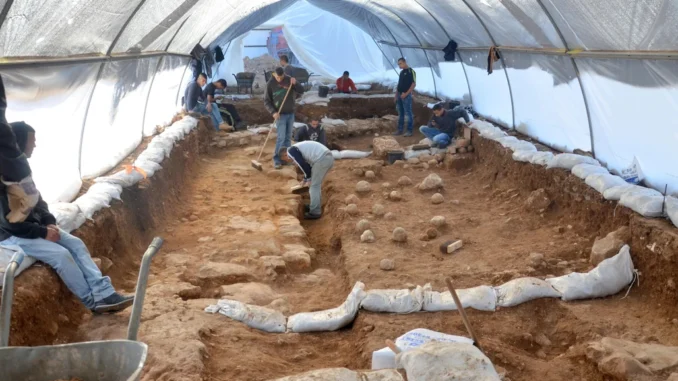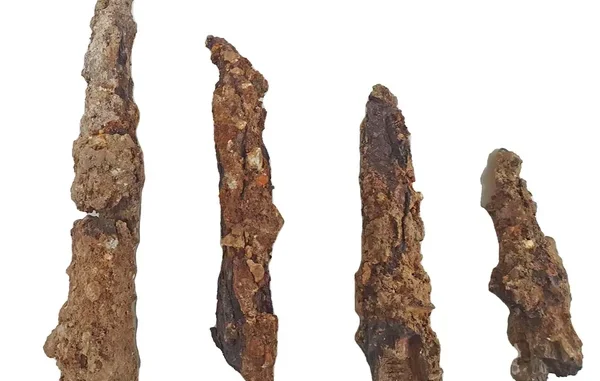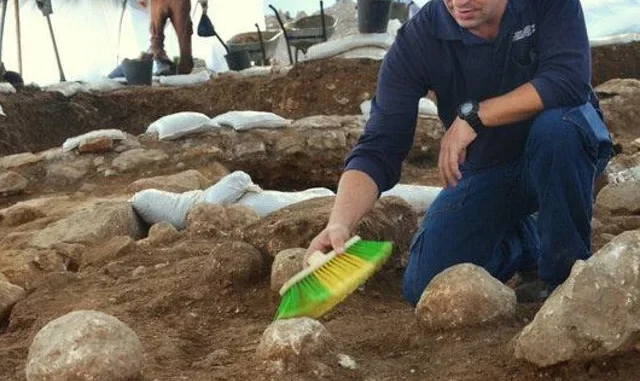New research suggests that when Roman forces besieged Jerusalem in the year 70, they were firing barrages from what is now known as Cats Square
Kfir Arbiv, Israel Antiquities Authority excavation director, cleans a ballista stone at the Russian Compound excavation site.Credit: Yoli Schwartz, Israel Antiquities Authority
In the year 70, Roman forces commanded by Titus besieged and then vanquished Jerusalem, destroying a third fortification wall begun decades earlier, abandoned, then completed in haste by the Jewish rebels.
Now new research by the archaeologist Kfir Arbiv of the Israel Antiquities Authority posits where the Roman forces may have concentrated at least some of their artillery machines: Cats Square.
That is the nickname today of a site in the modern Jerusalemite neighborhood of Nahalat Hashiva. Its formal name is Maccabi Mutzery-Mani Square, after an officer in the pre-state Haganah militia who died in 1948. How the nickname Cats Square arose is not clear, but one version says it was inspired by prostitutes who would hang out there.
Arbiv’s theory that Cats Square was one point from where the Romans fired on Jerusalem arose following some years of excavation at a site 200 meters away from that square: the Russian Compound, one of the most historic districts in the city.
Beneath the Russian Compound, the excavators, co-led by Dr. Rina Avner of the IAA found a section of Jerusalem’s destroyed third wall, and with it, hundreds of ballista (an ancient type of catapult) balls. It seems to be a moment frozen in time from the early part of the great battle between the Romans and the Jewish rebels, oddly undisturbed by the passage of time, perhaps because it lies outside the Ottoman Old City, explains Prof. Guy Stiebel of Tel Aviv University, an expert on ancient Roman warfare.
Walled cities go back thousands of years in the Middle East, and Jerusalem’s do as well. But the fortification wall we see today surrounding the Old City of Jerusalem is from the 16th century, when the Ottomans decided to repair the second ruined city wall from antiquity. What we do not see today is the third wall, which is gone, except for one tiny section between a gas station and the U.S. consulate on Naomi Kis Street.

The Russian Compound excavation site. The ballista stones are visible on the floor.Credit: Yoli Schwartz, Israel Antiquities Authority
The final fortification
According to historical records, during the late Second Temple period, in the year 40, King Agrippa II began building a third wall to protect Beit Zeta, a new neighborhood in northern Jerusalem. It would be the final act of fortifying Jerusalem, explains Amit Reem, director of Israel Antiquities Authority Jerusalem Region.
But the king did not complete it, in part for fear of provoking suspicion of disloyalty among the Roman overlords, led at that point by Emperor Claudius. Some work was continued by the Kanaim (41-44 CE), but it was only after the insurrection began in the year 66 that the wall was finished, by the Jewish rebels. However, they were likely short of resources and working in haste. Their effort would be in vain.
- Discovery sheds light on ancient Jerusalem under the Assyrians
- Oldest artifact ever found in Jerusalem, revealed
- Israeli Archaeologists Find New Section of Jerusalem’s Ancient Defensive Wall
“If the construction of the wall had continued as it was begun it would have been impossible to conquer the city inasmuch as it had been built with hewn stones 20 cubits long and 10 cubits wide that were assembled so perfectly that … it would have been impossible to dig underneath them with an iron tool or to move them with machines of war,” Flavius Josephus wrote. Evidently, the rebels could not achieve such construction quality.
Some of the ballista balls the archaeologists found by the ruins of the third wall were broken after shattering on the stone wall. There could have been thousands of the balls – and they weren’t only tossing diverse ballista balls designed to break down the wall. They were also catapulting spearheads, bolts, armor-piercing arrowheads, and smaller stones, gravel, and other objects to hit human targets.

Huge catapult arrowheads that were launched from ballista firing machines, found in the Russian Compound excavations.Credit: Kfir Arbiv, Israel Antiquities Authority
The ancient Romans didn’t invent the catapulting technique, but they adopted it with fervor. They were famed for using ballistrae, or as they are sometimes called, bolt-throwing machines, during sieges.
Depending on the projectile size, angles and more, objects could be hurled as much as 400 or even 500 meters, says Kfir. He adds that a distance of 400 meters is accepted in research based on previous studies at Masada and Gamla, for instance.




Leave a Reply
You must be logged in to post a comment.